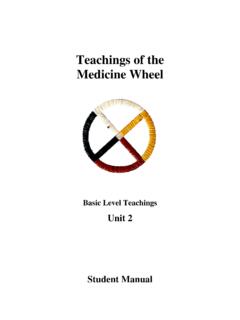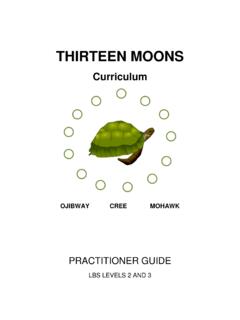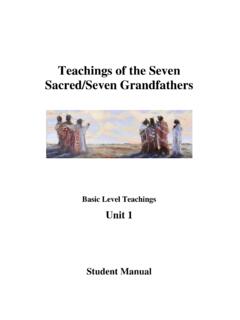Transcription of Teachings of the Medicine Wheel - ONLC
1 Medicine Wheel Teacher s Manual 0 Teachings of the Medicine Wheel Basic Level Teachings Unit 2 Teacher s Manual Medicine Wheel Teacher s Manual 1 Ontario Native Literacy Coalition [2010] Medicine Wheel Teacher s Manual 2 Table of Contents Teachings of the Medicine Wheel Page 4 Unit Lesson Unit teaching /Learning Strategies for teaching /Learning Strategies for Assessment and Getting Ready to Read Prior Knowledge Activation Reading Comprehension Strategies Lesson 1: Introduction to the Medicine Lesson 2: Gifts from the Lesson 3: Gifts from the Lesson 4: Gifts from the Lesson 5.
2 Gifts from the Lesson 6: Culminating Legend for Chart of Word List for References for Recommended Alternate Reading Resources Medicine Wheel Teacher s Manual 3 Medicine Wheel Teacher s Manual 4 Overview Unit Description The Medicine Wheel is a circular symbol representing the wholeness of traditional Native life. It is a perfectly balanced shape with neither top nor bottom, length nor width. It represents constant movement and change. It also represents and symbolizes unity, peace, harmony and courage.
3 It is a testimony of the human being s ability to survive and to maintain balance. The ultimate goal is to strike a harmonious balance in life. The circular form of the Medicine Wheel shows the relationship of all things in a unity, a perfect form, and suggests the cyclical nature of all relationships and interactions. Everything in the universe is part of a single whole. Lesson Timelines Lesson # Title Time Lesson 1 Introduction to the Medicine Wheel 140 minutes Lesson 2 Gifts of the East 140 minutes Lesson 3 Gifts of the South 140 minutes Lesson 4 Gifts of the West 140 minutes Lesson 5 Gifts of the North 140 minutes Lesson 6 Culminating Activity 200 minutes Unit Expectations On the surface of the Earth, all is given from the Four Sacred Directions of the Medicine Wheel which are: East, South, West and North.
4 Each direction contributes a vital part to the wholeness of the Earth. Each brings physical powers, as well as spiritual powers, as do all things. The focus of this unit is to make the student familiar with the Medicine Wheel and the Four Directions perspective. This unit introduces the student to the Medicine Wheel and how it functions as a teaching tool. The students will: explore domains of the Medicine Wheel -- the four directions, four aspects of human nature, four sacred plants, and the four elements, through recommended readings explore opportunities for using the Medicine Wheel model in other aspects of their lives transfer this model into other subjects such as mathematics, science and health demonstrate their perception and knowledge acquired throughout the unit.
5 Medicine Wheel Teacher s Manual 5 teaching /Learning Strategies Reading As students progress through the program, they are asked to read increasingly complex texts. The ability to understand and use the information in these texts is key to a student s success in learning. Successful students have developed a repertoire of strategies upon which to draw and know how to use them in different contexts. Developing students need explicit teaching of these strategies to become better readers. Developing readers need: Knowledge of different types of text and the best strategies for reading each of them Multiple and meaningful opportunities to practice reading in subject-specific contexts Opportunities to practice reading with appropriate resources Opportunities to talk about their reading and thinking Background knowledge in subject areas Expanded sight vocabulary and word-solving practice for subject-specific texts.
6 Strategies for previewing text, confirming their understanding, determining the most important ideas and the relationship among them, remembering what they read, and making connections and inferences Strategies and practice in independent reading in any context Reading is an active process of recognizing & interpreting print and graphic texts. Reading is a thinking process. Effective readers know that when they read, what they read is supposed to make sense. They monitor their understanding, so that when they miss the meaning of what they just read, they can select a reading strategy (such as rereading or asking questions) that will help them regain the meaning of the text.
7 Reading skills and strategies can be taught explicitly while students are learning subject-specific content through genuine reading tasks. Effective readers use strategies to understand what they read before, during and after reading. Students can be taught to be strategic and effective readers. Developing readers benefit from a variety of instructional approaches that demonstrate reading skills while the subject content is taught. Direct teaching , thinking aloud, modeling, discussion and small-group support are only a few of the approaches teachers use to help students become more strategic and effective readers in different contexts.
8 The following reading strategies are employed in this unit: self directed, teacher-directed, discussion, collaborative learning, individual conferencing, partner reading, peer tutoring, prediction, pre-reading strategies, relating reading to student s experiences, Internet research, guided imagery, small group discussion, and guest speakers Medicine Wheel Teacher s Manual 6 teaching /Learning Strategies Writing Students learn to write by writing. They need regular opportunities to write in all subjects. A consistent approach to the writing process and explicit instruction on the writing process by the subject teacher helps students become better writers.
9 Models of good writing in the subject area and feedback that is constructive (formative) are critical to students growth as writers. Developing writers need: Regular, meaningful opportunities to practice writing subject-specific contexts Teachers who model the writing process and demonstrate its usefulness Opportunities to talk about their writing Prior knowledge about language, subject content and the world Knowledge of different writing forms and their characteristics Expanded sight vocabularies for subject-specific writing Strategies to become an independent writer in any context The following writing, teaching and learning strategies are employed in this unit.
10 Response journal, summary writing, Venn diagrams, structured worksheets, word walls, glossary and visualization (graphic organizers). Assessment and Evaluation Assessment and Evaluation in this unit include: checklist for collaborative skills, formal evaluation of culminating task according to specific criteria (teacher-developed), self assessment, short answer questions, journal writing, observation, anecdotal notes, and reading/writing rubrics. Medicine Wheel Teacher s Manual 7 Getting Ready to Read Overview Before: Before reading, help students to connect new content and ideas with their prior knowledge by encouraging them to think about what they already know about the topic or the type of reading material.



